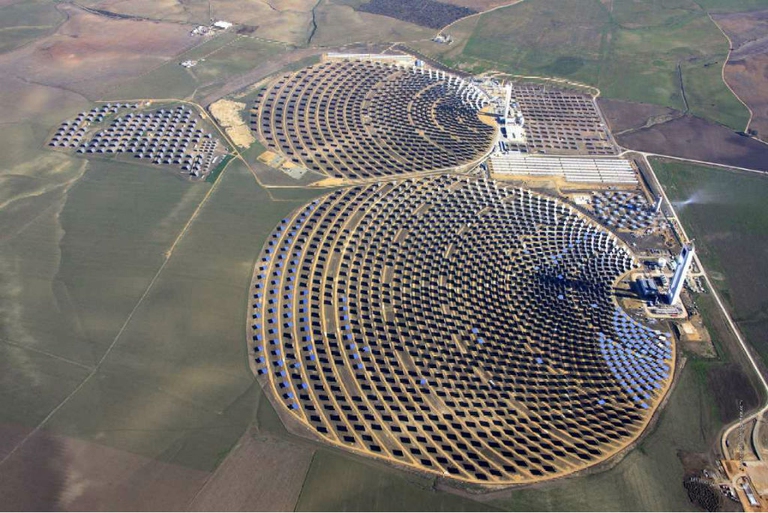
A group of experts in Tokyo suggested pouring radioactive water from Fukushima into the open sea. A marine biochemist explains the consequences of this absurd decision.
Con la potenza di 100 MW Atacama 1 sarà la prima centrale solare del genere in Sud America. E fornirà energia rinnovabile 24 ore su 24.
A 200-metre tower will capture the solar energy reflected by 10,600 heliostats – giants mirrors able to follow the sun’s motions in the sky – and will produce 110 MW of solar thermal energy in combination with 100 MW of photovoltaic energy produced by 392,000 panels, in the middle of the Atacama Desert, Chile.
The construction of the plant started last January and is set to be completed by 2017. The plant, Atacama 1, will be built in one of the areas with the highest levels of solar radiation and will cover a surface of almost 1,000 hectares. Atacama 1 will thus be able to produce electricity thanks to a combination of a photovoltaic system and heliostats. In fact, the heliostats will concentrate the solar radiation on the top of the 2,000-tonne receiver. The solar radiation will be used to heat 50,000 tonnes of molten salt that will transfer heat to turbines. The turbines, in turn, will produce energy day and night.
Once completed (despite the economic hardship of Abengoa, Spanish group that invested in the project), the power plant will be the first of its kind in South America, and will be able to provide energy to 410,000 households per year, whilst avoiding 870,000 tonnes of CO2 to be released in the atmosphere every year.
It’s not the first mega power plant to be built in Chile, particularly in the area of the Atacama Desert, where there’s a little bit of Italy, too. In fact, the Carrera Pinto solar power plant is one of the world’s largest, where Enel Green Power and Convert Italia completed and connected to the grid the first 20 MW, out of a total of 97.
“The photovoltaic market is rapidly growing in Chile. Two years ago, the installed capacity didn’t reach 4 MW, and 70 MW were still under construction. Currently, there are 170 MW installed and 170 under construction, whilst other 800 MW are scheduled for 2016,” explained Giuseppe Moro, CEO of Convert Italia. “Chile is one of the world’s leading countries for the investments in the solar field”.
Siamo anche su WhatsApp. Segui il canale ufficiale LifeGate per restare aggiornata, aggiornato sulle ultime notizie e sulle nostre attività.
![]()
Quest'opera è distribuita con Licenza Creative Commons Attribuzione - Non commerciale - Non opere derivate 4.0 Internazionale.
A group of experts in Tokyo suggested pouring radioactive water from Fukushima into the open sea. A marine biochemist explains the consequences of this absurd decision.
A federal court in Washington, D.C. has struck down the Dakota Access Pipeline, following years of campaigning by the Standing Rock Sioux tribe.
The Scottish island of Eigg is self-sufficient for its energy needs, relying almost entirely on renewable sources, especially thanks to a coordinated community effort.
President Magufuli in unmovable in going ahead with the Stiegler’s Gorge dam despite conservationists’ warnings of the damage it will cause the Selous Game Reserve’s ecosystem and wildlife.
A large dam along the Luangwa River in Zambia would have posed a serious risk to local people and wildlife, leading hundreds of thousands to oppose it. A call to which the government responded by halting plans to build it.
The first one megawatt solar power plant in the Chernobyl exclusion zone has become operational. This is the first step in a renewable energy development project promoted by the Ukrainian government in the area.
A tanker exploded at a gas and petrol station in Nigeria’s Nasarawa state on the 10th of September, killing 35 people and leaving some burned beyond recognition; 3 citizens had several spine and brain injuries, 2 of them are still on Intesive Care Units. Fela Habila , a local singer, is now stable and out of danger but
The largest tidal power plant in the world will be built in the Larantuka Straits. It will serve 100,000 people and help overcome some of the challenges of energy provision in Indonesia.
Robben Island’s solar energy micro-grid project will produce almost one million kilowatt hours of electricity annually, significantly reducing the cost and impact of buying diesel.








